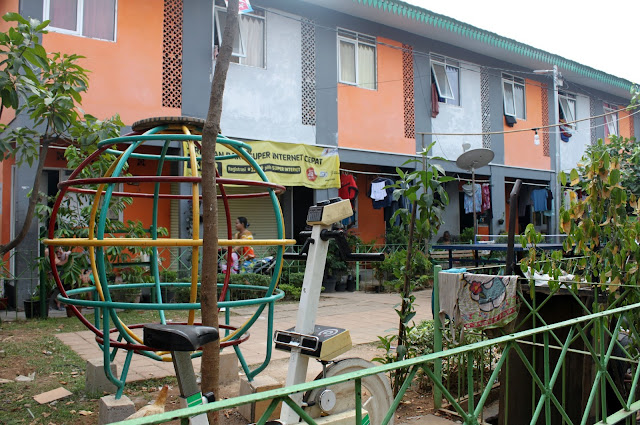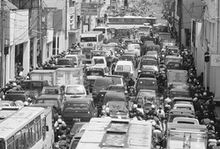Upgrading Housing Settlement for Jakarta's Poor Residents
The number of urban population in Indonesia increased
significantly from 101.3 million in 2000 to 137.6 million in 2015. This rapid
urbanization has caused many problems including the lack of housing for the
urban poor. Most poor residents of Indonesian major cities particularly Jakarta
live in informal housing settlements. They live in self-built inappropriate
houses and squatting in slums and squatter settlements. They are marginalized
urban residents that push their way to occupy state land such as disposal
sites, riverbanks, and railway tracks and private unoccupied land and illegally
construct their dwellings.
 |
| Kampung Deret in Petogogan, South Jakarta |
Housing provision for the urban poor in informal
housing settlements is also one of many agendas for Jakarta Governor Anies
Baswedan. During his campaign, Anies said he would not evict the residents in
informal housing settlements and would instead build vertical and layered
housing (rumah lapis) for them on
their land. The idea of rumah lapis is
not a new idea in the literature of upgrading housing settlement for the urban
poor. To some extent, I would argue that the Rumah Lapis program is a replication of the Kampung Deret program that was initiated by then Jakarta Governor Joko
Widodo in October 2013.
The Kampung
Deret program replaced substandard, unsafe and unhealthy housing units in the
Jakarta’s informal housing settlements with permanent housing units. The
program gained considerable support from among the poor in Jakarta’s informal
housing settlements. The program built
nearly 4,500 permanent housing units for the urban poor in Jakarta in less than
a year. Despite the support from the Jakarta’s urban poor, the Jakarta
city administration discontinued the Kampung Deret program at the end of 2014,
citing the lack of financial support from the Jakarta city council and the
legal issue of the lands occupied by the urban poor.
The idea of rumah
lapis and kampung deret is rooted
from John Turner’s seminal book Housing
by People: Towards Autonomy in Building Environments. Turner (1977) argued that housing was not only a commodity
but also a process or activity and the establishment of desirable housing
standards was absurd. Slum clearance programs only moved substandard houses to
new places particularly the urban periphery
There was no need to demolish slums because they were
part of the solution. John Turner’s idea of “self-help” was used to implement
the strategy of upgrading for improving and consolidating the existing homes of
slum dwellers. He identified that perceived security of tenure would result in
the progressive upgrading of slums through individual and community self-help. In
situ upgrading represents an incremental improvement to the delivery of housing
(Mistro and Hensher 2009). In situ upgrading aims to minimize the number of
slum dwellers that are relocated to another site and it will reduce the extent
of disruption to social and economic networks of slum dwellers.
 |
| Kampung Deret in Petogogan, South Jakarta in July 2015 |
One of the primary requirements of the Kampung Deret program was the legality of land tenure. Dwellers of Jakarta’s kampungs needed to show the evidence of formal or semi-formal land tenure to be eligible for the Kampung Deret program. The Jakarta city administration would grant land titles to the Jakarta’s kampungs dwellers with informal land tenure if they had settled on the same portion of the land for more than 20 years. The Kampung Deret program assisted Jakarta’s kampung dwellers to obtain land titles and housing certificates. The Kampung Deret program received significant support from Jakarta’s kampung residents because the program offered them land titles.
The Jakarta city administration was able to give the
kampung dwellers legal title to the lands they occupy in the first few cases of
Kampung Deret program but they failed to sustain the effort due to the
complicated process of land titling. The Kampung Deret program was finally discontinued
because the Jakarta city administration was not able to identify kampung
dwellers who occupy the land with legal land title.
The Jakarta city administration identified the
location of the Kampung Deret program that set out to be a residential area by
the Jakarta’s Spatial Plan 2030. The Jakarta’s Housing and Building Office
identified at least 392 kampungs that could be considered slums but many of
them were not qualified for the Kampung Deret program such as residents of
Bukit Duri because their area was zoned as green areas by the Jakarta’s Spatial
Plan 2030.
The planning process of the Kampung Deret program
started with the collaboration between the neighborhood leaders and the city
officials. The neighborhood leaders and the city officials identified the
residents of the selected neighborhoods who meet the requirements of the Program.
The priority was given to the residents who lived in detached semi-permanent
houses on flood prone areas, unhealthy areas or very dense areas. The Jakarta
city administration appointed the program consultants as the facilitator of the
program. The program consultants were paid the Jakarta city administration.
The consultants were assigned to assist the
beneficiaries in every stage of the Kampung Deret program. They were also
assigned to mediate the design and housing construction process and work
closely with the program beneficiaries. The program beneficiaries were
responsible to find and rent a temporary place while their housings are being
upgraded or built. The housing construction or upgrading process was about
three months. The housing construction in the Kampung Deret program was
efficient because the program used the standardized and fabricated building
materials or popularly known as Rumah
Instan Sederhana Sehat (RISHA).
Land tenure legalization is not a solution to the
upgrading housing settlement for Jakarta’s kampung dwellers. It is not legal
land title, but rather the perception of security of tenure that is most
important for the sustainability of the Kampung Deret program. The security of
land tenure can be given to Jakarta’s kampung dwellers by the tolerance and
discretion of Jakarta’s spatial plan. The Jakarta’s spatial plan needs to
integrate Jakarta’s kampungs into the formal and legal system.
The approach of menata
tanpa menggusur (upgrading without displacement) is the key ingredient of
the Kampung Deret program. In situ upgrading was appealing to Jakarta’s kampung
dwellers. In situ upgrading in the Kampung Deret program reduced disruptions to
social and economic networks of the urban poor.
Jakarta Governor Anies Baswedan should develop the
idea of Rumah Lapis program from the
Kampung Deret program. The strengths and weaknesses of the Kampung Deret
program that was implemented from October 2013 until the end of 2014 should be fully
examined by the Jakarta city administration in developing the Rumah Lapis program. Upgrading housing settlement in Jakarta’s informal
housing settlements also needs a broader development strategy to combat poverty
and inequality. In order to be effective, the Rumah Lapis program or other upgrading housing settlement program must
be incorporated into a community development strategy that addresses
employment, transportation, education, health services and access to formal financial
institution.




No comments:
Post a Comment